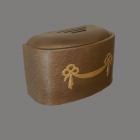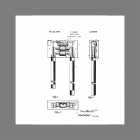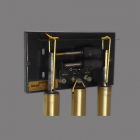NuTone Classic Tubular Door Chime with Machined Anvils

NuTone Drape Door Chime 1938
The NuTone Classic Style D-495 Long Bell Door Chime featured a metal cover with a drape ornament. The Classic was available in ivory or bronze with a brass-finished ornament. The cover had an integrated dome to accommodate the special mechanism to employ a NuTone patented scheme for suspending the bells. Instead of solid plugs to suspend the chime tubes, the invention employed “anvils” with several claimed advantages. The mechanism has a serrated sheet metal platform to hang the loops for the bells.
The necessity for a domed cover was rather simple to solve and the result was successful — identical covers and others of the same general style were used on various long bell resonator and compact chimes for many years. Still, other issues caused these anvil equipped chimes to be relatively short lived. Manufacturing costs for machining the anvils may have been higher than conventional plugs. Or perhaps the exaggerated swing of the tubes caused problems with adjusting the strikes. In any case, NuTone abandoned anvil type bells in favor of more conventional plugs and hangers when they resumed chime production following World War 2.
The anvils were explained in the 1940 patent:
The present invention is based upon the discovery that a pronounced improvement in the tone quality and the volume of sound produced by a chime is obtained when a prong or rod-like anvil ls provided at the end of the chime tube for receiving the striking blows. This anvil is mounted rigidly upon the tube, or is made as an integral part of it, and projects axially beyond the end of the tube for the reception of blows either from one or a series of strikers disposed at various points along its length. When this anvil is struck instead of the tube then full resonant tones are produced from the chime and no metallic overtones or harsh sounds are developed. The sound produced by the instrument is noticeably different, both qualitatively and quantitively. from the sound produced from a chime tube of the conventional structure. The sound developed by the chime does not vary as the anvil is struck at difierent points upon its length. This characteristic enables two solenoid strikers to be placed side by side for operating upon the anvil without variation in the volume of sound or purity of its tone. Moreover, the volume of sound produced from a relatively feeble blow upon the anvil. (sic) [F}or example, a blow from a solenoid operated upon six-volt current, is at least equal to, and in most cases much greater than the sound produced from a striker operated from an eight or fourteen volt transformer and arranged to strike the tube in the conventional manner.
| Manufacturer | Unknown |
| Location of Manufacture | Unknown |
| Date of Manufacture | ~ 1938 |
| Cover | Rolled steel with stamped brass ornament |
| Bells | Brass |
| Height | 37 3/4 inches |
| Width | 6 3/4 inches |
| Depth | 2 1/4 inches |
| Notes | ElectraChime Collection. Restored |


